on Volvo Steel, Gaming Tech, Shanghai Sales, Fiat EVs, Robots, Trends, Colors & Gas Savings
Addressing emissions with materials. . .providing a Matrix-like experience. . .a remarkable sales number. . .Fiat in the UK. . .a startling Porsche interior. . .and more
Volvo Addressing Steel Emissions
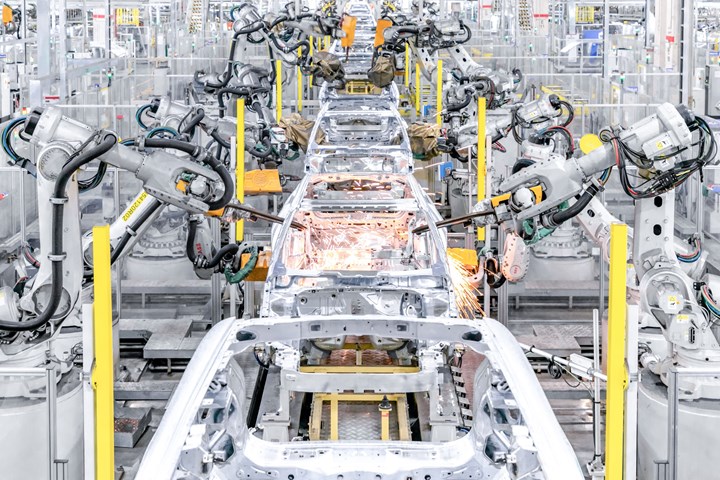
When the material you use to make your vehicles accounts for about 33% of your emissions and you’re going to zero emissions, you’ve got more than a minor challenge. (Image: Volvo)
Here’s a not-so-fun fact: Volvo Cars calculates that producing the steel for use in a Volvo in 2021 was responsible for 33% of all its production-related emissions.
For a company that has pledged to be climate-neutral by 2040, that steel number is a big factor.
So here’s some good news to minimize that: Volvo Cars has become the first automotive member of the SteelZero initiative.
Volvo is no stranger to more environmentally benign steel: last year it began working with Swedish steel maker SSAB on its HYBRIT program. That effort is working to replace coking coal in steel production with green-electricity and green hydrogen.
“A sustainable approach to steelmaking is not just good news for the environment, it is also good business as it limits our exposure to future climate risks and regulations”--Kerstin Enochsson, chief procurement officer at Volvo Cars.
(Note well chief procurement officer, an individual whom you might imagine is primarily concerned with cost-downs, not the environment. Clearly, they’re serious about this.)
SteelZero?
It is a membership organization the members of which publicly commit to procuring 100% net-zero-emissions steel by 2050—and arguably more importantly: 50% by 2030. (As that is closer in time, it is more locked in than the date 28 years from now.)
SteelZero is operated by the Climate Group in cooperation with ResponsibleSteel. That last-named has members including “steel makers, mining companies, buyers of steel from automotive and construction as well as civil society organisations focused on labour rights, biodiversity, climate change and many other important issues.”
In addition to climate, it considers the other two pillars of ESG.
There are more than 100 members. Its members account for more than 10% of global steel production.
///
The Game’s the Thing

That is not a real city (unless you live in The Matrix, as it was taken from a technical demo, The Matrix Awakens: An Unreal Engine 5 Experience). Unreal Engine is being used by Volvo for its forthcoming HMI. (Image: Unreal Engine)
Speaking of Volvo. . .
There are three billion gamers on the planet according to the 2021 Newzoo Global Games Market Report.
Epic Games says that its Fortnite has “over 350 million accounts and 2.5 billion friend connections.”
Qualcomm Technologies has shipped more than three billion Adreno GPUs, often used for gaming and apps.
Billions.
So what does this have to do with Volvo?
Well, it so happens that Epic Games is the developer of a real-time 3D creation tool, Unreal Engine. Not only is it used to design games, but hyper-realistic renderings for design.
And it can also be used to produce HMIs for vehicles.
Unreal. Real.
Volvo has announced that it is using Unreal Engine for its next-gen HMI, which will be used in the flagship EV that it will be revealing later this year (said to be a three-row successor to the XC90, possibly named “Embla”).
Qualcomm has been working with Epic Games on optimizing Unreal Engine for its Snapdragon platforms.
HMI and infotainment systems in the forthcoming Volvo will be running on third-generation Snapdragon Cockpit platforms. (See how it all comes together?)
This will result in HMI systems that operate twice as fast as existing ones. And the graphics generation and processing will be up to 10x faster.
“When you bring interactive, high-resolution graphics running in real-time into the car, you open the door to a vast range of new ways to inform and entertain everyone inside.”--Heiko Wenczel, Epic Games’ Director of Automotive and HMI for Unreal Engine.
A thought
Consider that number of gamers.
A percentage will be buying vehicles sooner or later.
Their standard for what they expect on screens is going to be much higher than previous generations of consumers.
While the graphics and animations in many new vehicles are good, good is probably insufficient.
///COVID in China; Sales in Shanghai

NIO ET5 all-electric midsize sedan. In announcing its May deliveries, the Shanghai-based company noted, “NIO plans to further ramp up the production capacity to a higher level by working closely with supply chain partners and to accelerate the delivery recovery starting from June, in light of the recent supportive developments in the COVID-19 situation and the strong order inflow.” (Image: NIO)
Although COVID had and continues to have an effect on everything from supply chain fractures and shipping snafus and from reduced inventory availability to massive worker shortages, consider this from LMC Automotive’s “China Light Vehicle Sales Update, June 2022”:
“The Shanghai Automobile Sales Trade Association surveyed more than 100 dealers in Shanghai and established that these dealers were closed with no cars sold in April. Insurance data showed that 1,195 PV [passenger vehicle] units were sold in Shanghai in April, down by 98% YoY.”
The population of metro Shanghai is 28.5-million people.
There are only two U.S. states—California (39.6 million) and Texas (29.7 million)—with more people than metro Shanghai.
1,195 passenger vehicles in a month.
The magnitude of that COVID lockdown in Shanghai is hard to overestimate.
///Fiat Going All-Electrified—in the UK
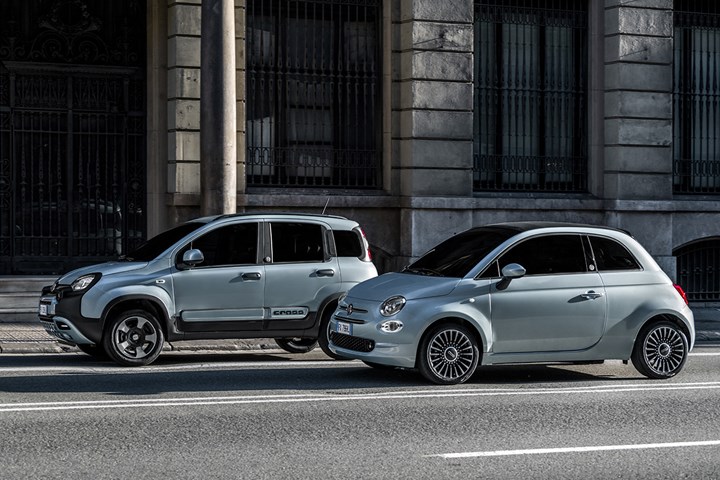
The Fiat Panda and Fiat 500. The brand will be going all-EV in the UK at the start of July. This July. (Image: Fiat)
While numerous OEMs are talking about their transition to all electrified vehicles at some point in the future (generally 2030), if you live in the UK and you’re interested in getting a Fiat, that point in the future is July 1.
As in this July 1.
Fiat has announced that it is transitioning to an all-electrified portfolio everywhere (yes, by 2030). The UK is a market that will be ahead of the global curve.
The Fiat electrified offering includes hybrid versions of the 500, Panda, 500X and Tipo. The New 500 was an EV from its inception.
Through May, according to the UK’s Society of Motor Manufacturers and Traders (SMMT), Fiat had a 1.4% share of the UK market.
That said, compared with the same period (January through May) in 2021, Fiat sales were up 40.87%. The total number of Fiats sold in the UK through May: 9,282.
Greg Taylor, Fiat and Abarth UK Managing Director:
“This step in Fiat’s history marks a pivotal point in our commitment to providing affordable and sustainable mobility solutions for all of our customers.”
Observation
Although Fiat has been pretty much all-electrified in the UK since it brought in the 500X and Tipo hybrids in February, perhaps by making a statement about its offerings in the market might provide a boost to its position there. It probably can’t hurt.
///
Robots and Auto
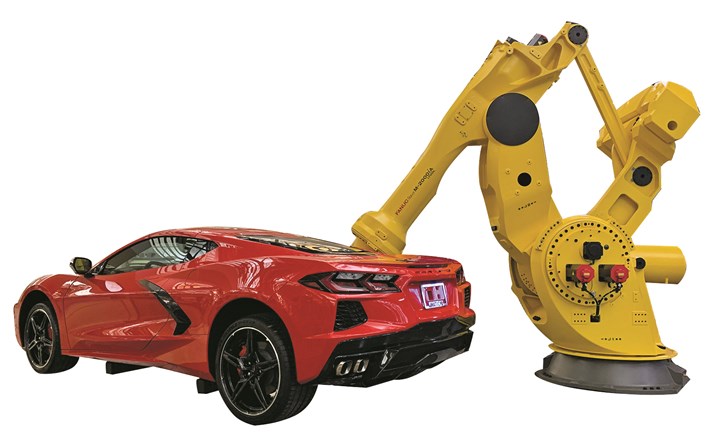
That is a Fanuc M-2000iA lifting a Corvette. The six-axis robot has a capacity of 5,060 pounds, so given that the car weighs about 3,366 pounds, it is capable. Robots have been lifting things in auto for decades. (Image: Fanuc)
The industrial robot industry has a lot to thank the auto industry for because, arguably, were it not for the auto industry, the industrial robot industry wouldn’t be what it is today—at least not for far longer.
- Consider: George Devol filed for a patent for a programmable robotic arm—a.k.a., the “Unimate”—in 1954.
- Devol and Joseph Engelberger established the first robot company in the world, Unimation, in 1956.
- The first application of a Unimate occurred in 1961 at a GM Inland Fisher Guide plant in New Jersey in a diecasting operation.
The rest, as they say, is history.
Why bring this up?
Because the Association for Advancing Automation (A3) announced the robot sales in North America for Q1.
The 11,595 robots ordered, representing a value of $646-million, sets a record for a single quarter.
A3 said orders from automotive were “still strong.”
But it pointed out that for seven out of the last nine quarters non-automotive companies have ordered more robots than the auto industry.
In Q1 2022 automotive bought 5,476 robots and non-auto bought 6,122.
However. . .
The non-automotive grouping includes the following industries: Metals; Plastics and Rubber; Semiconductor and Electronics/Photonics; Food and Consumer Goods; Life Sciences/Pharma/Biomed; and All Other Industries.
All of them vs. auto.
Yes, the original still really dominates as the others begin to catch on.
///
Global Market Trends, Emphasis on Global
The EY Mobility Consumer Index 2022 Study has some very good news for OEMs: like 63% of those surveyed plan to buy a vehicle in the next 12 months and the remaining 37% within 24 months.
And the news is similarly good for producers of electric vehicles as 20% of the surveyed say they would prefer an EV for their next set of wheels. That’s up from 7% that EY found in its 2020 survey.
However. . .
There are a few things to know about the EY study.
There were approximately 13,000 people surveyed this past March.
These people are in 18 countries.
- In China and India 1,002 people were surveyed in each.
- In the UK, Australia, Germany, US, Canada, Mexico and Japan the number was 1,000 each.
- In Spain 503. In France 502. In the Netherlands 501. In both New Zealand and Norway 500 each.
- In Italy and Singapore 302 each.
- And in Sweden and South Korea 300 each.
The point is, when you look at the numbers realize that they are (1) global and (2) the U.S. gets averaged in.
Take that buying a vehicle in the next 12 months question.
Turns out that 75% of those in China, 74% in India and 66% of those in Mexico expressed an interest.
In the U.S. the number is 48%.
And as for the interest in buying an EV: the global average is 20%.
The number in the U.S. is 7% in 2022, which is down from the 8% in 2021. But up from the 5% in 2020.
(How did the global number get so high? Here’s one data point: in China the number interested in a fully electric vehicle is 37%, up from 17% in 2021 and 15% in 2020.)
///
Porsche Colors With a Different Pallet
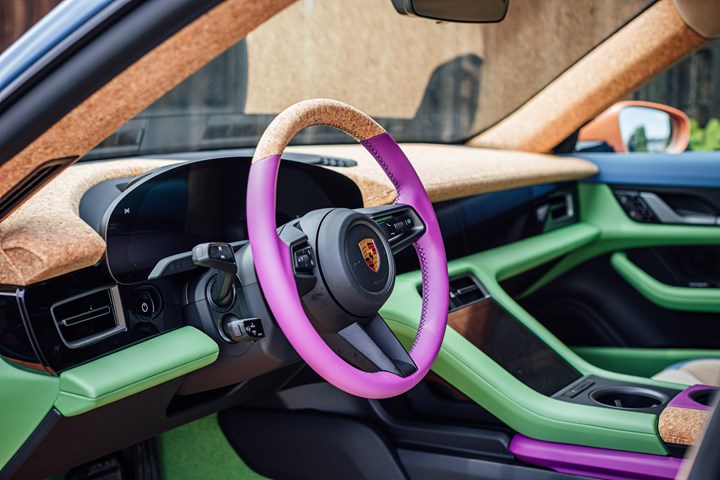
While this may appear to be a toy, it isn’t. Not by a long shot. (Image: Porsche)
If you simply glance at the image of that interior above, chances are you’re not going to think to yourself, “Ah, a Porsche Taycan 4 Cross Turismo,” unless, of course, your eye somehow zeroed in on the badge in the center of the steering wheel. . .despite the “Loretta Purple” and “Ashley Green” colors, to say nothing of the extensive use of cork on the top of the IP and on the A-pillars.
That is a real, Porsche-produced vehicle that the German company did with “designer and influencer Sean Wotherspoon.”
Wotherspoon first became highly visible for his design of the Nike Air Max 1/97 SW. Yes, the shoe. It combines the upper of an Air Max 97 with an Air Max 1 outsole and midsole. The shoe, launched in 2018, also uses green and purple colors (see that picture above as a reminder) and corduroy, a material used on the interior of the Porsche.
Corduroy is something of a heritage material for the marque: It was first used on the seats of the Porsche 356 in 1952.
Two bits of curious information:
- Cork. Volker Müller, Head of Colour and Trim at Style Porsche, admits, “Working with cork presented a number of challenges to our trimmers.” So to accomplish the installation they used laminated material that comes in roll form, allowing the shapes to be more readily cut.
- Color. Muller told Wotherspoon that to assure the colors used were the right ones, each had to have a unique name. So why Loretta and Ashley (as well as Nash Blue and Sean Peach)? Those are names of Wortherspoon’s family members.
If you’re going to do an imaginative concept vehicle you might as well make one that’s, well, imaginative.
///
Summer Bonus Driving Tips
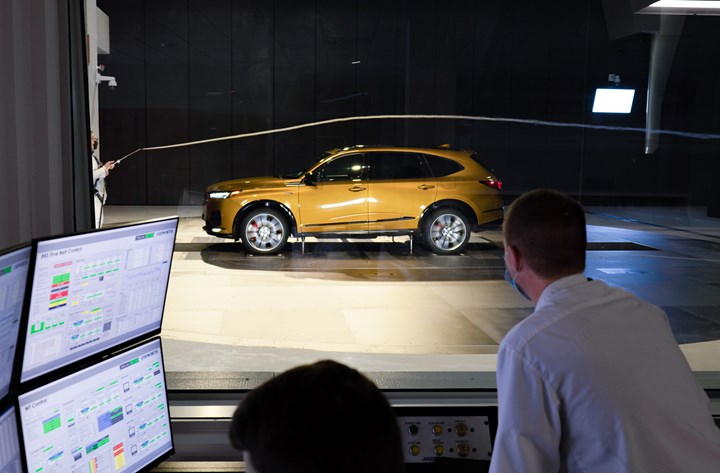
Honda opened a $124-million wind tunnel facility in East Liberty, Ohio, in March. Shown here is an MDX running on a five-belt rolling road system. The objective is to develop aerodynamic vehicles, so take those rooftop carriers off when you’re not using them. (Image: Honda)
1. Oak Ridge National Laboratory conducted a study of 74 light-duty vehicles and determined that a vehicle traveling at 80 mph has a 27% decrease in fuel economy compared to it traveling 60 mph.
Or simply: slower is better.
(The sweet spot, the researchers found, is from 40 to 50 mph, but. . . .)
2. The Dept. of Energy points out those roof-top cargo boxes that are now to road trips what storage units are to houses can reduce fuel economy by 10 to 25% when traveling at Interstate speeds (65 to 75 mph).
Pack less for your next roady?
(Let’s face it: designers and engineers to a lot of work making vehicles as aerodynamic as possible to improve efficiency, so when you don’t need that container, remove it.)
Enjoy the ride.
===
RELATED CONTENT
-
on lots of electric trucks. . .Grand Highlander. . .atomically analyzing additive. . .geometric designs. . .Dodge Hornet. . .
EVs slowdown. . .Ram’s latest in electricity. . .the Grand Highlander is. . .additive at the atomic level. . .advanced—and retro—designs. . .the Dodge Hornet. . .Rimac in reverse. . .
-
On Electric Pickups, Flying Taxis, and Auto Industry Transformation
Ford goes for vertical integration, DENSO and Honeywell take to the skies, how suppliers feel about their customers, how vehicle customers feel about shopping, and insights from a software exec
-
GM Develops a New Electrical Platform
GM engineers create a better electrical architecture that can handle the ever-increasing needs of vehicle systems


.jpg;width=70;height=70;mode=crop)






